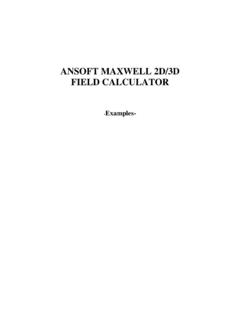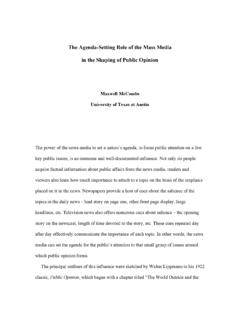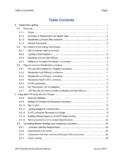Transcription of THE MAXWELL-BOLTZMANN DISTRIBUTION FUNCTION
1 1 THE MAXWELL-BOLTZMANN DISTRIBUTION FUNCTION In this exercise you will use Excel to create a spreadsheet for the MAXWELL-BOLTZMANN speed DISTRIBUTION and then plot the speed DISTRIBUTION for particles of two different molecular weights and temperatures. By varying the molecular weight and temperature you can see how these parameters affect the speed DISTRIBUTION . Also, from the plots you can determine the most probable speed for a given molecular weight and temperature and the fraction of molecules with a particular speed at this molecular weight and temperature, and how both are affected by these variables. Next, you will calculate an energy DISTRIBUTION . From the energy DISTRIBUTION , you can determine the fraction of molecules with energies above a given threshold value. This will be used as an indication of the number of molecules possessing enough energy to undergo a reaction.
2 By varying the temperature you can see how temperature affects reactivity. By now you should be familiar with the commands you will need to execute in Excel for completing this exercise. You will be given a bare-bones spreadsheet as a starting point and, using this handout, add to the spreadsheet to create the plots for the speed and energy distributions. At the end of the session you should hand in a print out of the plots you created (speed and energy distributions) and answers to the questions on both parts. DISTRIBUTION OF MOLECULAR SPEEDS: Molecules at any given temperature do not all have the same speed but in fact a DISTRIBUTION of speeds given by the MAXWELL-BOLTZMANN DISTRIBUTION dNN=4 (M2 RT)3/2c2e Mc22 RTdc (1) where N is the total number of molecules in the sample, dN/N is the fraction of molecules with speed between c and c+dc, M is the molecular weight in kg/mole, T the temperature in oK, and R the gas constant constant (J/K).
3 If we plot dN/N vs. c (see 2 figure 1) we can graphically see what this complicated FUNCTION looks like. As you will find, the FUNCTION has a fast rising portion at smaller values of c, reaches a peak, and has a decreasing tail as c increases. (m/s)dN/NFigure 1 Now in Excel you will create the data points for dN/N and c and then plot dN/N vs. c. You will create two DISTRIBUTION functions, each with a different temperature and molecular weight. Finally, you will be able to change either molecular weight or temperature (the plots will be updated for each change) for example, you can fix the temperature and change the molecular weight or vice versa and see how these variables affect the DISTRIBUTION FUNCTION . For example, if temperature increases does the DISTRIBUTION get broader or narrower? Similarly, how does molecular weight affect the DISTRIBUTION ?
4 Creating the spreadsheet for the speed DISTRIBUTION FUNCTION and plotting the FUNCTION . Open the spreadsheet titled speed . There will be some entries made to this spreadsheet. In particular all relevant equations and constants have already been 3 entered for you. Save this file to your disk (File -> SAVE AS. Give the file a name and save to DISK). 1) First note the units which will be used (SI units). So for example, the molecular weight of the molecule is in kg/mole not g/mole, and speed in m/s not cm/s. 2) There are two entries for molecular weight, MW1 and MW2, and two for temperature, temp1 and temp2. You will calculate the DISTRIBUTION FUNCTION for each pair (MW1,temp1) and (MW2,temp2). The term gasconst refers to the gas constant (R = J/oK). 3) The DISTRIBUTION FUNCTION has been broken up into three terms (i) a term that is independent of speed (called coeff1 for (MW1,temp1) and coeff2 for (MW2,temp2) in the spreadsheet), (ii) the c2 term and (iii) the exponential term.
5 Splitting up the FUNCTION this way, just makes it easier to create a spreadsheet for calculating the DISTRIBUTION FUNCTION . The DISTRIBUTION FUNCTION is obtained by multiplying the three terms. dN/ Ndc=4 (M2 RT)3/2c2e Mc2RT2 (2) coeff term exponential term c2 term 4) The term labeled dc is the interval or step size over which the DISTRIBUTION FUNCTION will be calculated. 5) In the column labeled speed you will enter the values of the speed over which the DISTRIBUTION FUNCTION will be calculated, in intervals of dc. For example, if the first point is 0, the next point is 0 + dc, the next 0 + 2 dc, etc. In the spreadsheet dc has been set to be 20 m/s. 6) In the column labeled speed x speed , you will calculate the square of the speed.
6 7) In the column labeled exp1 , you will calculate the exponential term for (MW1,temp1) and in the column exp2 the exponential term for (MW2,temp2). 4 8) In the column labeled distribution1 you will calculate the value of the DISTRIBUTION FUNCTION for (MW1,temp1) for each speed value, and in the column distribution2 the same for (MW2,temp2). 9) Finally the column labeled speed (before the columns for distribution1 and distribution2), is a copy of the speed column (see 5 above). It is positioned here to make plotting easier. Fill in the speed column (column A) The first entry is 0 in this column, the second 0 + dc which in this example is 20 m/s. Copy cell A27 and paste in cells A28 to A215. Fill in the speedxspeed column (column B) Copy cell B27 and paste in cells B28 to B215 Repeat the same for the columns labeled exp1, exp2, speed, distribution1, distribution2 copy the 27th cell of each column and paste into the 28th to the 215th cell.
7 You have now created the spreadsheet for plotting the speed DISTRIBUTION . Next you will plot these data points. Select columns H26 to I26 down to H215 and I215. In the Insert -> Chart menu select XY scatter. For the chart sub-type select the middle left option (scatter with data points connected by smooth lines). Finish the plot on the same sheet. Now you should have a plot of the two DISTRIBUTION functions for (MW1,temp1) and (MW2,temp2) that looks like figure 1. Vary the values of MW1, MW2, temp1, and temp2 and see how the DISTRIBUTION changes. 5 QUESTIONS 1) How does molecular weight affect the DISTRIBUTION does the DISTRIBUTION get broader or narrower as molecular weight increases? How does temperature affect the DISTRIBUTION ? 2) The speed corresponding to the peak of the speed DISTRIBUTION curve is called the most probable speed, since the largest fraction of molecules move at this speed (hence, it is the most probable speed).
8 From the graph determine the most probable speed for a particle of molecular weight of kg/mole and a temperature of 1000o K? 3) From the graph determine the fraction of molecules with speed 1040 m/s, molecular weight kg/mole and temperature of 1000o K. How does this fraction change if (a) the molecular weight is lowered to kg/mole (temperature kept at 1000o K), (b) the molecular weight is lowered to kg/mole (temperature kept at 1000o K) (c) the temperature is lowered (molecular weight kept at kg/mole)? 4) Can you find a temperature where the fraction of molecules with c=1040 m/s and M= kg/mole does not change for small increases or decreases in temperature? (Hint: You can do this using Excel but there is also an analytical method for solving the problem.) ENERGY DISTRIBUTION Now you will calculate an energy DISTRIBUTION for a given temperature.
9 The kinetic energy of a particle of molecular weight M is given by E=12Mc2 (3) If we substitute c=2EM (4) in the equation for the maxwell Boltzmann DISTRIBUTION it can be shown that that the fraction of molecules with energies between E and E+dE (f(E)) is given by: 6 f(E)=dNE/NdE=2 (1 RT)3/2Ee ERT (5) Figure 2 shows a plot of the energy DISTRIBUTION (dNE/NdE vs. E) at a given temperature. The energy DISTRIBUTION has a sharply rising component at low energies, peaks and then decreases rapidly at larger energies. The width of the DISTRIBUTION is affected by the temperature of the molecules. (J)f(E)Figure 2 We can use this energy DISTRIBUTION to determine the number of molecules that have energies above a certain threshold energy, where this threshold energy is the minimum amount of energy that a molecule must have to undergo a reaction.
10 Also, by plotting the energy DISTRIBUTION we can see how temperature affects this fraction of molecules above the threshold energy and hence how temperature can affect the yield of a reaction ( the number of molecules that successfully go from reactant to product). Creating a spreadsheet for the energy DISTRIBUTION . 7 Open the spreadsheet titled energy . Note that there are some entries made in this spreadsheet. In particular the columns are already labeled and temp, gasconst, and dE are defined and entered. However, you will have to enter your own formulas. Save this file to your disk (File -> SAVE AS. Give the file a name and save to DISK). 1) Units are SI units. Energy in Joules (J). 2) The term temp refers to the temperature of the molecules (in oK) and the term gasconst, the gas constant (R, units J/K) 3) The equation for the energy DISTRIBUTION has been split into three parts (i) a constant term called coeff in the spreadsheet, (ii) E term and (iii) the exponential term.














